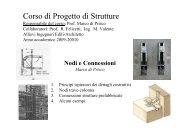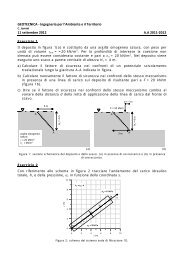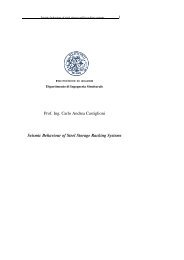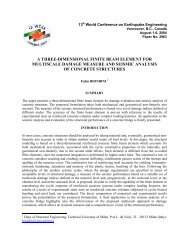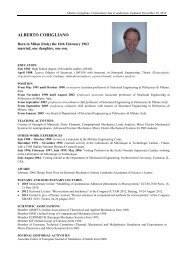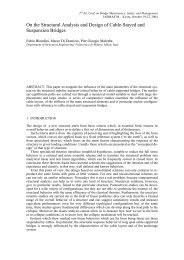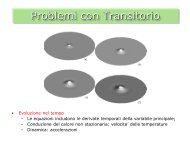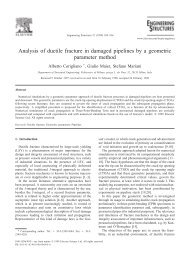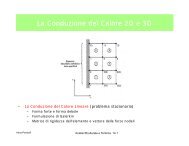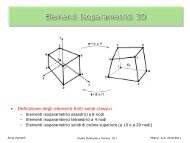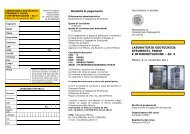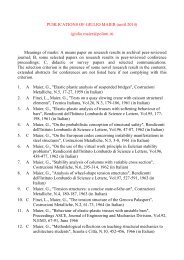Finite Strip Modeling for Optimal Design of Folded Plate Structures
Finite Strip Modeling for Optimal Design of Folded Plate Structures
Finite Strip Modeling for Optimal Design of Folded Plate Structures
You also want an ePaper? Increase the reach of your titles
YUMPU automatically turns print PDFs into web optimized ePapers that Google loves.
1054 A. Bergamini, F. Biondini / Engineering <strong>Structures</strong> 26 (2004) 1043–1054adopted to check the convergence <strong>of</strong> the iterativeprocedure. Finally, Fig. 14 shows the correspondingevolution <strong>of</strong> the objective function f(x) and<strong>of</strong> its componentsf V (x) and f P (x).4.5. Box-girder bridge deck with internal diaphragmsThe box-girder bridge deck shown in Fig. 15(a), withlength L ¼ 40:0 m, total width B ¼ 16:0 m andheightH ¼ 2:0 m, is considered. Besides its self-weight, theweight <strong>of</strong> the non-structural elements g p ¼ 4kN=m 2andthe service loadp ¼ 2:0 kN=m 2 , the structure issubjected to the four alternative loading conditionsshown in Fig. 15(a), with q ¼ 8kN=m 2 . The thicknessdistribution andboth the shape andtopology <strong>of</strong> thecross-section which minimize the total volume, are searched<strong>for</strong>.To this purpose, the topologies associatedtothe four alternative symmetrical cross-sections shownin Fig. 15(b), each <strong>of</strong> them derived from the first fundamentalone by eliminating or not one or more internaldiaphragms, are considered. The search processleads to an optimal solution which corresponds to thetwo-cellular box girder shown in Fig. 15(c), with a totalvolume Vðx opt Þ¼7:737 m 3 =m. It is worth noting thatthe high value <strong>of</strong> thickness <strong>of</strong> the bottom slab intension is due to the hypothesis <strong>of</strong> homogeneousmaterial andelastic behavior. The disposition <strong>of</strong>proper longitudinal rein<strong>for</strong>cement, designed with referenceto the effective composite andnon-linear nature <strong>of</strong>the material, clearly allows a lower thickness <strong>of</strong> theconcrete slab.Finally, with reference to the path <strong>of</strong> the search process,Fig. 16 shows the distribution <strong>of</strong> the topologies atthe vertices <strong>of</strong> the complex andthe evolution <strong>of</strong> theobjective function f(x) <strong>for</strong> the current best solutionduring the iterative process.5. ConclusionsThe problem <strong>of</strong> finding the optimal shape, size andtopology <strong>of</strong> prestressed folded plate structures undermultiple loading conditions has been investigated. Thedesign problem has been <strong>for</strong>mulated as a mathematicaloptimization problem, accounting <strong>for</strong> both static andkinematic constraints, andit has been solvedby usinga numerical algorithm basedon the complex method.The structural analyses needed <strong>for</strong> the optimizationprocess have been per<strong>for</strong>medby using the finite stripmethod. A number <strong>of</strong> applications have shown theeffectiveness <strong>of</strong> the proposedprocedure.In particular, the design tools presented in this papercan usefully be appliedat the conceptual design stage,where the designer is usually interested in comparingbetween them a variety <strong>of</strong> alternative optimal solutions,derived, <strong>for</strong> example, by using different designmodels. These solutions, which the proposed procedureidentifies with wide generality, rationality and objectivity,can be then usedas a basis <strong>for</strong> a more detaileddesign <strong>of</strong> the rein<strong>for</strong>cement. Clearly, future developmentsare expectedin order to obtain a better control<strong>of</strong> the design problem, especially on the definition <strong>of</strong>the design constraints, which should also account <strong>for</strong>technological aspects, as well as <strong>for</strong> aesthetical andadditional functional requirements.References[1] ASCE. <strong>Design</strong> <strong>of</strong> cylindrical concrete shell ro<strong>of</strong>s. Manual <strong>of</strong>engineering practice. New York (NY): ASCE; 1952, p. 31.[2] Belegundu AD, Chandrupatla TR. Optimization concepts andapplications in engineering. Upper Saddle River (NJ): Prentice-Hall; 1999.[3] Bergamini A, Biondini F. Optimisation <strong>of</strong> folded plate structures.Proceedings <strong>of</strong> the Second International Conference onAdvances in Structural Engineering and Mechanics (ASEM02),Seoul, Korea, August 21–23. 2002.[4] Biondini F, Bontempi F, Malerba PG. Ottimizzazione di <strong>for</strong>madi strutture a folded-plates. Proceedings <strong>of</strong> the 13th C.T.E. Conference,Pisa, Italy, November 9–10–11. 2000 [in Italian].[5] Cheung YK. <strong>Finite</strong> strip methodin structural analysis. Ox<strong>for</strong>d:Pergamon Press; 1976.[6] Kristek V. Theory <strong>of</strong> box girder bridges. Prague: John WileyandSons; 1979.[7] Loo YC, Cusens A. The finite strip methodin bridgeengineering. London: E. & F.N. Spon; 1978.[8] Malerba PG, Toniolo G. Metodi di discretizzazionedell’analisi strutturale. Milan, Italy: Masson Editore; 1981[in Italian].[9] Martinez Y Cabrera F, Menni C. I ponti a cassone monocellularea pr<strong>of</strong>ilo de<strong>for</strong>mabile. Technical Report, 33. Istituto diScienza e Tecnica delle Costruzioni, Politecnico di Milano,Tamburini Editore, Milan, 1974 [in Italian].[10] Mortenson ME. Mathematics <strong>for</strong> computer graphicsapplications. New York (NY): Industrial Press; 1999.[11] Nielsen MP. Limit analysis andconcrete plasticity. Boca Raton(FL): CRC Press; 1999.[12] Rao SS. Engineering optimization—theory andpractice. NewYork (NY): John Wiley andSons; 1996.[13] Schlaich J, Scheef H. Concrete box-girder bridges. Structuralengineering documents, 1e. International Association <strong>for</strong> BridgeandStructural Engineering (IABSE); 1982.




